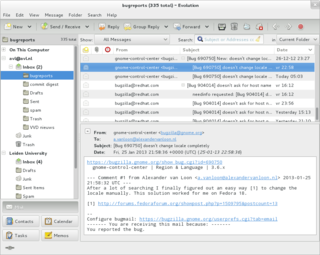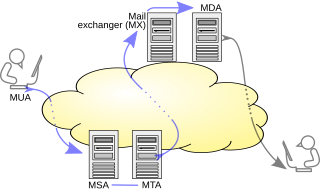Related Research Articles

Electronic mail is a method of transmitting and receiving messages using electronic devices. It was conceived in the late–20th century as the digital version of, or counterpart to, mail. Email is a ubiquitous and very widely used communication medium; in current use, an email address is often treated as a basic and necessary part of many processes in business, commerce, government, education, entertainment, and other spheres of daily life in most countries.
Within the Internet email system, a message transfer agent (MTA), or mail transfer agent, or mail relay is software that transfers electronic mail messages from one computer to another using the Simple Mail Transfer Protocol. In some contexts the alternative names mail server, mail exchanger, and MX host can be used to describe an MTA.
The Simple Mail Transfer Protocol (SMTP) is an Internet standard communication protocol for electronic mail transmission. Mail servers and other message transfer agents use SMTP to send and receive mail messages. User-level email clients typically use SMTP only for sending messages to a mail server for relaying, and typically submit outgoing email to the mail server on port 587 or 465 per RFC 8314. For retrieving messages, IMAP is standard, but proprietary servers also often implement proprietary protocols, e.g., Exchange ActiveSync.

Sendmail is a general purpose internetwork email routing facility that supports many kinds of mail-transfer and delivery methods, including the Simple Mail Transfer Protocol (SMTP) used for email transport over the Internet.
procmail is an email server software component — specifically, a message delivery agent (MDA). It was one of the earliest mail filter programs. It is typically used in Unix-like mail systems, using the mbox and Maildir storage formats.
Sender Policy Framework (SPF) is an email authentication method which ensures the sending mail server is authorized to originate mail from the email sender's domain. This authentication only applies to the email sender listed in the "envelope from" field during the initial SMTP connection. If the email is bounced, a message is sent to this address, and for downstream transmission it typically appears in the "Return-Path" header. To authenticate the email address which is actually visible to recipients on the "To:" line, other technologies such as DMARC must be used. Forgery of this address is known as email spoofing, and is often used in phishing and email spam.
Greylisting is a method of defending e-mail users against spam. A mail transfer agent (MTA) using greylisting will "temporarily reject" any email from a sender it does not recognize. If the mail is legitimate, the originating server will try again after a delay, and if sufficient time has elapsed, the email will be accepted.
A bounce message or just "bounce" is an automated message from an email system, informing the sender of a previous message that the message has not been delivered. The original message is said to have "bounced".

Postfix is a free and open-source mail transfer agent (MTA) that routes and delivers electronic mail.
Email authentication, or validation, is a collection of techniques aimed at providing verifiable information about the origin of email messages by validating the domain ownership of any message transfer agents (MTA) who participated in transferring and possibly modifying a message.

A message submission agent (MSA), or mail submission agent, is a computer program or software agent that receives electronic mail messages from a mail user agent (MUA) and cooperates with a mail transfer agent (MTA) for delivery of the mail. It uses ESMTP, a variant of the Simple Mail Transfer Protocol (SMTP), as specified in RFC 6409.
The Sender Rewriting Scheme (SRS) is a scheme for bypassing the Sender Policy Framework's (SPF) methods of preventing forged sender addresses. Forging a sender address is also known as email spoofing.
policyd-weight is a mail filter for the Postfix mail transfer agent (MTA) written in Perl. It allows postfix to evaluate mail envelope information and to score mail against several DNS-based Blackhole Lists (DNSBL) before the mail is queued. The final score will determine whether a mail is rejected or accepted, in which case it is usually then subject to more resource intensive checks by a virus scanner and spam filter.

MIMEDefang is a GPL licensed framework for filtering e-mail. It uses sendmail's "Milter" API, some C glue code, and some Perl code to let the user write high-performance mail filters in Perl.
Email forwarding generically refers to the operation of re-sending a previously delivered email to an email address to one or more different email addresses.
An Internet messaging platform is any system on the Internet that exchanges messages for the purpose of human communications.
Backscatter is incorrectly automated bounce messages sent by mail servers, typically as a side effect of incoming spam.
A bounce address is an email address to which bounce messages are delivered. There are many variants of the name, none of them used universally, including return path, reverse path, envelope from, envelope sender, MAIL FROM, 5321-FROM, return address, From_, Errors-to, etc. It is not uncommon for a single document to use several of these names.

An e-mail agent is a program that is part of the e-mail infrastructure, from composition by sender, to transfer across the network, to viewing by recipient. The best-known are message user agents and message transfer agents, but finer divisions exist.
Amavis is an open-source content filter for electronic mail, implementing mail message transfer, decoding, some processing and checking, and interfacing with external content filters to provide protection against spam and viruses and other malware. It can be considered an interface between a mailer and one or more content filters.
References
- ↑ "SENDMAIL RELEASE NOTES: 8.12.0/8.12.0". Sendmail. 2001-09-08. Retrieved 2020-08-03.
- ↑ "Postfix before-queue Milter support: Limitations". Postfix . Retrieved 2020-08-03.
- ↑ Wietse Venema. "Postfix 2.3 Change log: 20060301-20060515" . Retrieved 2020-08-03.